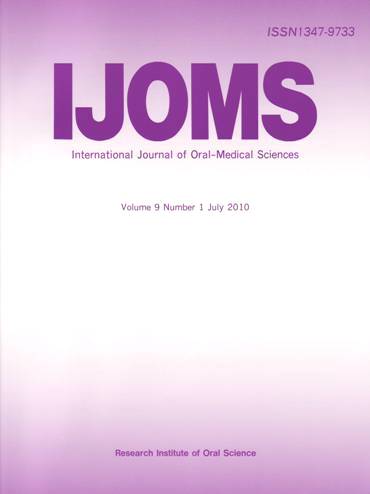Volume 11, Issue 4
Displaying 1-13 of 13 articles from this issue
- |<
- <
- 1
- >
- >|
Original Articles
-
2013Volume 11Issue 4 Pages 229-235
Published: 2013
Released on J-STAGE: April 27, 2013
Download PDF (308K) -
2013Volume 11Issue 4 Pages 236-241
Published: 2013
Released on J-STAGE: April 27, 2013
Download PDF (4678K) -
2013Volume 11Issue 4 Pages 242-248
Published: 2013
Released on J-STAGE: April 27, 2013
Download PDF (1274K) -
2013Volume 11Issue 4 Pages 249-260
Published: 2013
Released on J-STAGE: April 27, 2013
Download PDF (3709K) -
2013Volume 11Issue 4 Pages 261-267
Published: 2013
Released on J-STAGE: April 27, 2013
Download PDF (4763K) -
2013Volume 11Issue 4 Pages 268-273
Published: 2013
Released on J-STAGE: April 27, 2013
Download PDF (571K) -
2013Volume 11Issue 4 Pages 274-279
Published: 2013
Released on J-STAGE: April 27, 2013
Download PDF (365K) -
2013Volume 11Issue 4 Pages 280-290
Published: 2013
Released on J-STAGE: April 27, 2013
Download PDF (3202K) -
2013Volume 11Issue 4 Pages 291-299
Published: 2013
Released on J-STAGE: April 27, 2013
Download PDF (6546K) -
2013Volume 11Issue 4 Pages 300-306
Published: 2013
Released on J-STAGE: April 27, 2013
Download PDF (1100K) -
2013Volume 11Issue 4 Pages 307-314
Published: 2013
Released on J-STAGE: April 27, 2013
Download PDF (5869K) -
2013Volume 11Issue 4 Pages 315-319
Published: 2013
Released on J-STAGE: April 27, 2013
Download PDF (284K)
Case Reports
-
2013Volume 11Issue 4 Pages 320-324
Published: 2013
Released on J-STAGE: April 27, 2013
Download PDF (1652K)
- |<
- <
- 1
- >
- >|
